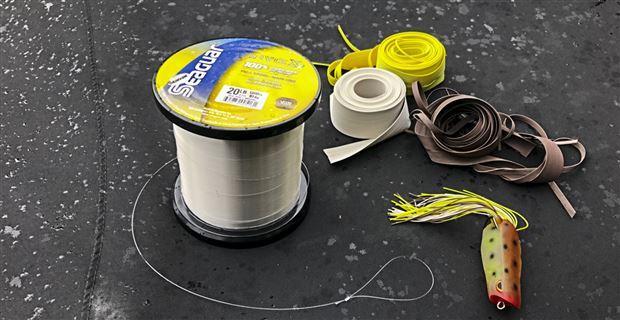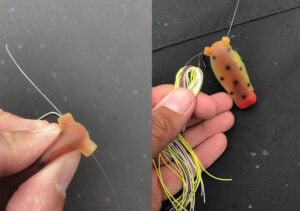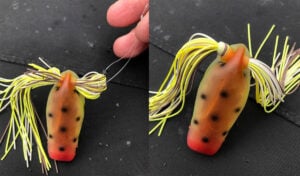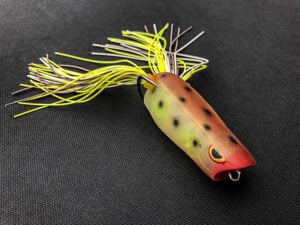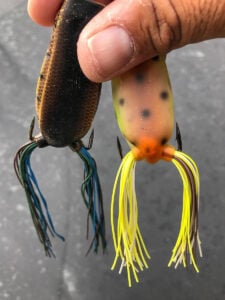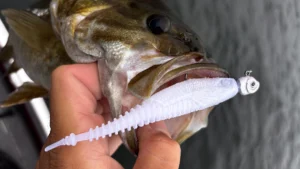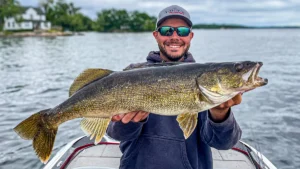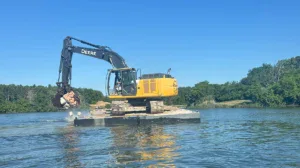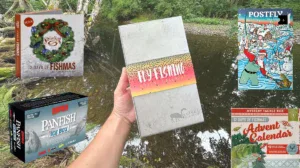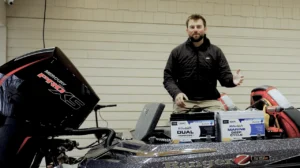We all spend a bunch of money on our fishing tackle and want it to last long enough to be worth the investment. There is no worse feeling than opening a tackle box and finding metal rusted or plastic or rubber melted on your fishing lures. Fortunately hooks and split rings are easy to replace. You can also easily replace the melted or gummed-up legs on your favorite topwater frog.
I love throwing a SPRO Bronzeye Frog. It’s one of my favorite ways to fish. Because they are so effective, I keep a lot of colors sizes and options in my boat through most of the spring, summer and fall. The legs will sometimes get gummed up because of extremely hot summer days or several seasons of running around in my tackle boxes and in and out of the water.
You can combat sticky frog legs by adding powder like we showed in this tip.
But if you do have some get gummed up, don’t throw your frogs out. The legs are easy to fix.
Here is an 8-step process for replacing the old legs on your favorite frog or several frogs that might have not worn well in the heat of the backseat of your truck or tackle compartment of your boat.
- Remove the old legs
- Cut new legs
- Make a knot in middle of new legs and pull really tight
- Pinch frog and insert heavy fishing line into aligned leg holes
- Create a loop knot and trim tag
- Insert one side of new legs into loop and fold in half on loop
- Pull loop and legs through to the other side
- Pull knot of legs into center between two leg holes
Start by simply pulling on one end of the old legs to remove. If they are brittle or gummy, it might take a bit more effort to get all pieces out of the frog. You will see the legs are knotted in the middle to keep the legs from moving in and out of the frog while fishing.
Cut new legs and knot
You can find round rubber and silicone material for making new frog legs online. I got mine from LurePartsOnline.com. You can get a variety of colors and cut to length. Don’t cut too many strands as the bulkier the legs, the harder they are to pull through the frog. Also cut them a bit longer because you need to put that half knot in the middle to keep the legs from pulling out of the frog while fishing. I pull this knot very tight to make it as small as possible.
Pinch frog and insert fishing line
I pull the legs through the frog with a heavy piece of 20-pound fluoro or mono fishing lines. If you pinch the frog just right, you can get the leg holes to line up and pass the fishing line through one hole and out the other. Then I will tie a loop on the end that won’t slip. I cut the tag end short too, so it won’t hang up pulling the legs through.
Insert one side of legs in loop and pull
Drop one side of the legs into the loop about half way and pinch around the loop as you pull the loop into the frog. You be pulling the doubled legs on one side through the first hole and out the other. As you get the legs out the other side, you will have to gently pull one side of the legs so they come all the way out. And then finally you will pull your knot into the center between the two leg holes. It helps to wet the legs for this process so they will slide a little easier through the frog leg holes. Again if you make your legs too thick with too many strands, this will be more difficult.
Finishing up
I will pull the leg holes opposite each other and get them to stretch back out straight. They will sometimes be pinched together. You just have to work them back into shape a little. Finally I will trim my legs to the desired length. I usually don’t do this until I am on the water and can see how the frog is sitting and acting with the legs I have on there.
If you buy a bunch of frogs and don’t use them all in a season or two, chances are you will have some legs that are deteriorating on you. So this is a great way to make those topwater fishing frogs you paid good money for last a lot longer than usual.
